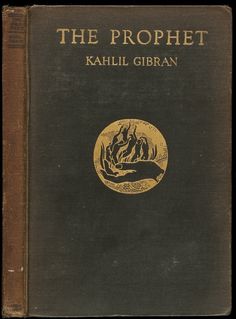
Byblos is a city in the Keserwan-Jbeil Governorate of Lebanon. It is believed to have been first occupied between 8800 and 7000 BC and continuously inhabited since 5000 BC, making it one of the oldest continuously inhabited cities in the world. During its history, Byblos was part of numerous civilizations, including Egyptian, Phoenician, Assyrian, Persian, Hellenistic, Roman, Fatimid, Genoese, Mamluk and Ottoman. The city is a UNESCO World Heritage Site.

Gibran Khalil Gibran, usually referred to in English as Kahlil Gibran, was a Lebanese-American writer, poet and visual artist, also considered a philosopher although he himself rejected the title. He is best known as the author of The Prophet, which was first published in the United States in 1923 and has since become one of the best-selling books of all time, having been translated into more than 100 languages.
Articles related to or originating from Lebanon, including people, places, things, and concepts, are:

The Prophet is a book of 26 prose poetry fables written in English by the Lebanese-American poet and writer Kahlil Gibran. It was originally published in 1923 by Alfred A. Knopf. It is Gibran's best known work. The Prophet has been translated into over 100 different languages, making it one of the most translated books in history, as well as one of the best selling books of all time. It has never been out of print.

May Elias Ziadeh was a Lebanese-Palestinian poet, essayist and translator, who wrote different works in Arabic and in French.

The National Museum of Beirut is the principal museum of archaeology in Lebanon. The collection begun after World War I, and the museum was officially opened in 1942. The museum has collections totaling about 100,000 objects, most of which are antiquities and medieval finds from excavations undertaken by the Directorate General of Antiquities. About 1300 artifacts are exhibited, ranging in date from prehistoric times to the medieval Mamluk period.

Aitou is a village located in the Zgharta District in the North Governorate of Lebanon. Its population is Maronite Catholic.

The tourism industry in Lebanon has been historically important to the local economy and remains to this day to be a major source of revenue for Lebanon. Before the Lebanese Civil War, Beirut was widely regarded as "The Paris of the Middle East" or also "The Pearl of the Middle East" often cited as a financial and business hub where visitors could experience the Levantine Mediterranean culture, cuisine, history, archaeology, and architecture of Lebanon.
The Murex d'Or is a Lebanese award created by two Lebanese physicians, Zahi and Fadi Helou to recognize achievements in the domain of art in Lebanon, the Arab region and the world. The first Murex d'Or ceremony took place on June 4, 2000. The name of the award is a tribute to Phoenician Murex sea snails, which were used to dye cloth in imperial Tyrian purple.

Khalil or Khaleel means friend and is a common male first name in the Middle East, North Africa, West Africa, East Africa, Central Asia and among Muslims in South Asia and as such is also a common surname. It is also used amongst Turkic peoples of Russia and African Americans. The female counterpart of this name is Khalila or Khaleela.

The architecture of Lebanon embodies the historical, cultural and religious influences that have shaped Lebanon's built environment. It has been influenced by the Phoenicians, Romans, Byzantines, Umayyads, Crusaders, Mamluks, Ottomans and French. Additionally, Lebanon is home to many impressive examples of modern and contemporary architecture. Architecturally notable structures in Lebanon include ancient thermae and temples, castles, churches, mosques, hotels, museums, government buildings, souks, residences and towers.
Gebran is a well-known given name and family name in Arabic. It is also transliterated as Gibran, Jebran, Jibran, Joubran, Jubran, Goubran and Gubran. It might also appear with an additional "e" at the end, like in Gebrane, Gibrane etc.

Tartej is a village in the Byblos District of the Keserwan-Jbeil Governorate, Lebanon. Its average elevation is 1,100 meters. Qornet Ain el-Deb is the highest peak in the mountain (1,859 meters), peak Ain al-Marbout (1,774 meters), Jouret al-Maktoul (1,715 meters), Jouret al-Touti (1,480 meters) and al-Wata (1,088 meters).

The Byblian royal inscriptions are five inscriptions from Byblos written in an early type of Phoenician script, all of which were discovered in the early 20th century.

Hjoula is a municipality in the Byblos District of Keserwan-Jbeil Governorate, Lebanon. It is 70 kilometers north of Beirut. Hjoula has an elevation of between 920 and 1,100 meters above sea level. Hjoula has a total land area of 528 hectares. The village of Hjoula is known for its fertile soil and its woods, as well as Early Cretaceous fossils.

The Osorkon Bust, also known as the Eliba'l Inscription is a bust of Egyptian pharaoh Osorkon I, discovered in Byblos in the 19th century. Like the Tabnit sarcophagus from Sidon, it is decorated with two separate and unrelated inscriptions – one in Egyptian hieroglyphics and one in Phoenician script. It was created in the early 10th century BC, and was unearthed in c.1881, very likely in the Temple of Baalat Gebal.

Umm Al Amad, or Umm el 'Amed or al Auamid or el-Awamid, is an Hellenistic period archaeological site near the town of Naqoura in Lebanon. It was discovered by Europeans in the 1770s, and was excavated in 1861. It is one of the most excavated archaeological sites in the Phoenician heartland.












